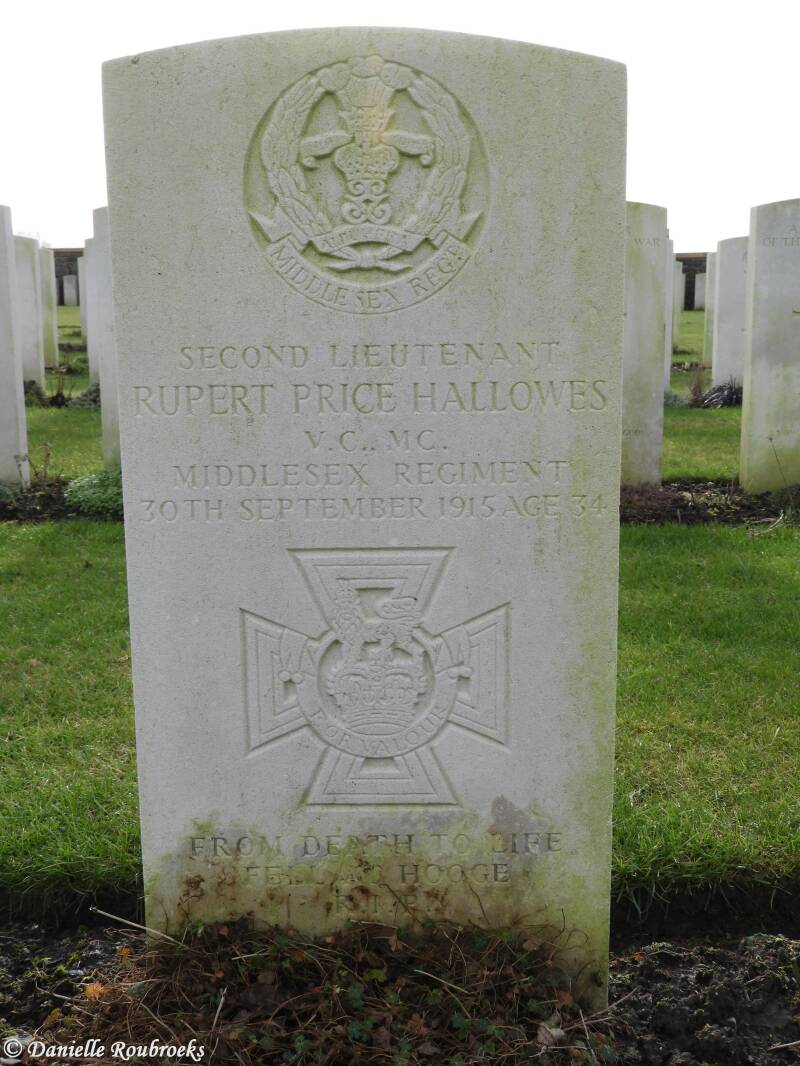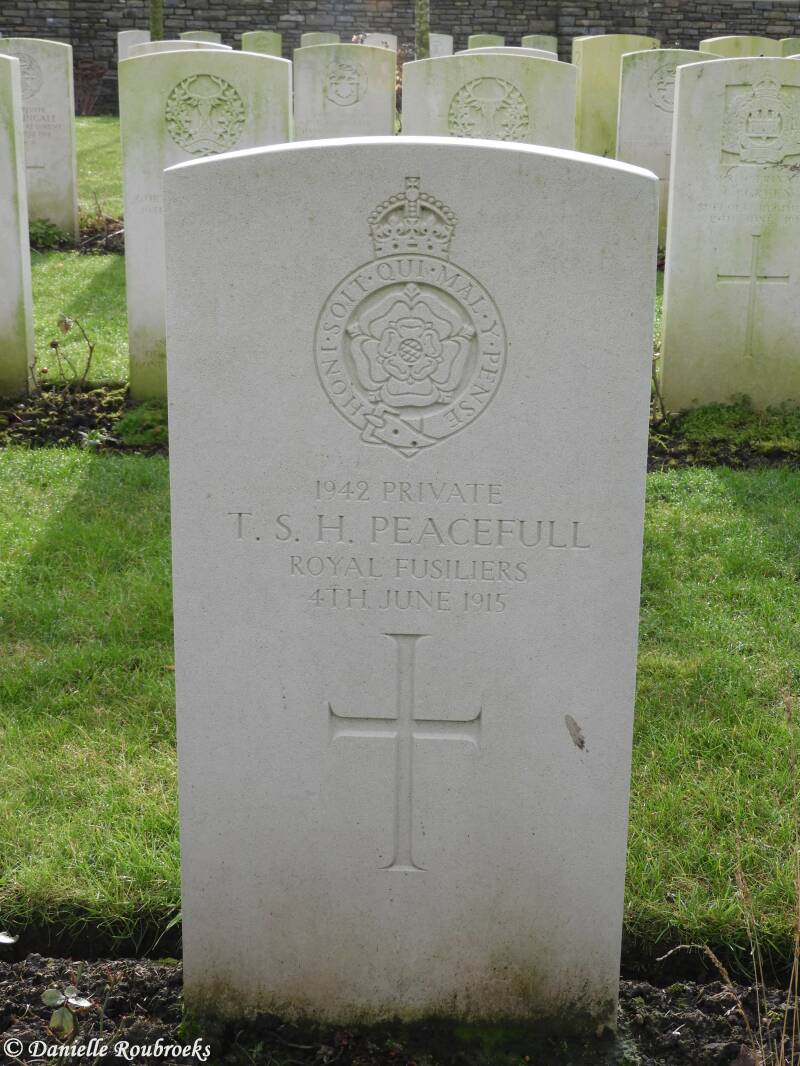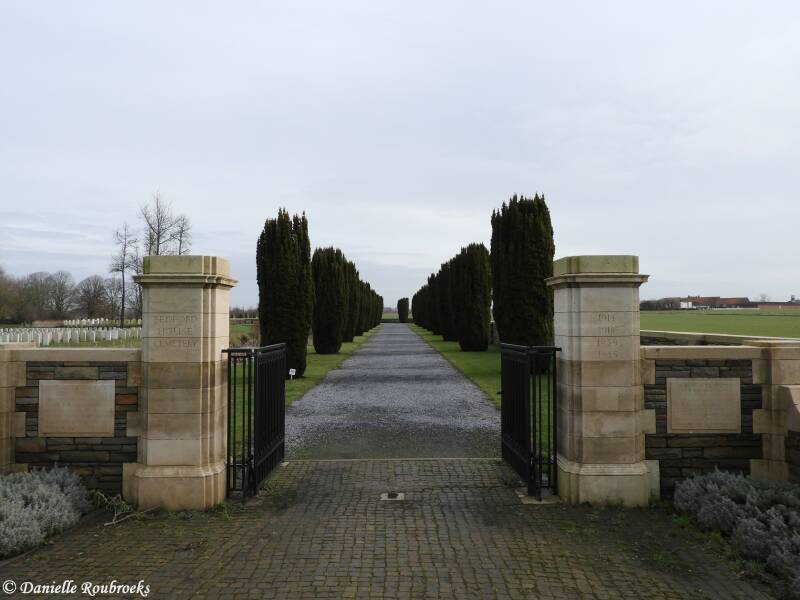Bedford House Cemetery
History Information (Source: CWGC)
Zillebeke village and most of the commune were in the hands of Commonwealth forces for the greater part of the First World War, but the number of cemeteries in the neighbourhood bears witness to the fierce fighting in the vicinity from 1914 to 1918. Bedford House, sometimes known as Woodcote House, were the names given by the Army to the Chateau Rosendal, a country house in a small wooded park with moats. Although it never fell into German hands, the house and the trees were gradually destroyed by shell fire. It was used by field ambulances and as the headquarters of brigades and other fighting units, and charcoal pits were dug there from October 1917.
In time, the property became largely covered by small cemeteries; five enclosures existed at the date of the Armistice, but the graves from No.1 were then removed to White House Cemetery, St. Jean, and those from No.5 to Aeroplane Cemetery, Ypres.
Enclosure No.2 was begun in December 1915, and used until October 1918. After the Armistice, 437 graves were added, all but four of which came from the Ecole de Bienfaisance and Asylum British Cemeteries, both at Ypres.
Enclosure No.3, the smallest, was used from February 1915 to December 1916; the burials made in August-October 1915 were largely carried out by the 17th Division.
Enclosure No.4, the largest, was used from June 1916 to February 1918, largely by the 47th (London) Division, and after the Armistice it was enlarged when 3,324 graves were brought in from other burial grounds and from the battlefields of the Ypres Salient. Almost two-thirds of the graves are unidentified.
Enclosure No.6 was made in the 1930s from the graves that were continuing to be found on the battlefield of the Ypres Salient. This enclosure also contains Second World War burials, all of them soldiers of the British Expeditionary Force, who died in the defence of the Ypres-Comines canal and railway at the end of May 1940. The canal lies on high ground on the west side of the cemetery.
Commonwealth casualties buried in smaller cemeteries were either concentrated into Bedford House Cemetery after the war or if lost, are now commemorated in Bedford House Cemetery.
In all, 5,139 Commonwealth servicemen of the First World War are buried or commemorated in the enclosures of Bedford House Cemetery. 3,011 of the burials are unidentified but special memorials commemorate a number of casualties known or believed to be buried among them. Other special memorials name casualties buried in other cemeteries whose graves could not be found on concentration. Second World War burials number 69 (3 of which are unidentified). There are 2 Germans buried here. The cemetery was designed by W.C. Von Berg.
Served with
· United Kingdom (1829)
· Canadian (218)
· Australian (122)
· New Zealand (17)
· Indian (8)
· South African (3)
· German (1)
Served in
· Army (2194)
· Air Force (3)
· Navy (1)
VICTORIA CROSS
Second Lieutenant Rupert Price HALLOWES - 4th Bn. Middlesex Regiment
Died 30 September 1915 Age 34
Country of Service: United Kingdom
Awards: Victoria Cross, Military Cross, Mentioned in Despatches
Citation
An extract from the "London Gazette", No. 29371, dated 16th Nov., 1915, records the following:- "For most conspicuous bravery and devotion to duty during the fighting at Hooge between 25th September and 1st October, 1915. Second Lieutenant Hallowes displayed throughout these days the greatest bravery and untiring energy, and set a magnificent example to his men during four heavy and prolonged bombardments. On more than one occasion he climbed up on the parapet, utterly regardless of danger, in order to put fresh heart into his men. He made daring reconnaissances of the German positions in our lines. When the supply of bombs was running short he went back under very heavy shell fire and brought up a fresh supply. Even after he was mortally wounded he continued to cheer those around him and to inspire them with fresh courage."
Grave Reference: Enclosure No.4 XIV. B. 36.
(Source: Wikipedia)
The original headstone had Peaceful as the surname. when the name was discovered to be Peacefull, the CWGC produced a new headstone to replace the incorrect/damaged stone. in July 2018, the replacement was installed with relatives of Private Peacefull and Michael Morpugo present.
Pvt Thomas Samuel Henry Peacefull was just 19 years old when he enlisted in the spring of 1914. He joined the 4th Battalion, Royal Fusiliers, and fought at the First Battle of Ypres. Sadly, he died of his wounds on 4 June 1915, shortly after the second German attack. He volunteered for the front, for many young men this seemed "the opportunity of a lifetime" .
During a visit to "Flanders Fields", author Michael Morpurgo (also known from "War Horse") was on this cemetery, when the tomb and the name of Private Peaceful drew his attention. At that moment he decided that his new novel would carry this name. The story is that of a young soldier, Thomas 'Tommo' Peaceful, who overlooks his young life, the night before a major attack. A nice overview of the quiet country life 100 years ago, about dreams, an unrequited love and disappointments ... and how he ended up with his brother Charlie at the front. The story is completely fictional.
The Peacefulls were originally farm labourers from Wivenhoe, Essex, but in the late 19th Century, when work dried up, Thomas’s father moved to Battersea, South London, with his wife Mathilda Burnett. He found work as a builder’s labourer and the couple had six children; Thomas was their second son. When, in March 1914, Field Marshal Lord Kitchener, the Secretary of State for War, asked for a million young men aged between 19 and 30 to volunteer, Thomas Peacefull and two of his brothers jumped at the chance. After his basic training, Private Peacefull arrived in France on November 11, 1914. Joining the Army was thought to open doors to a different future. For a young lad from a poor family, it must have seemed the opportunity of a lifetime. But few had expected the appalling conditions that awaited them.
Private Peacefull, along with many new recruits, went to Flanders to join the 9th Brigade of the 3rd Division of the British Army. In Morpurgo’s novel, Private Peaceful is seriously wounded but survives. Sadly, the real Thomas Peacefull did not. Military records show that he ‘died of wounds’ on June 4, 1915, although was not killed outright in action. He might well have been wounded in the Second Battle of Ypres, which began on April 22, involved four separate assaults, and finally ended on May 25. Conditions there were horrific; a quarter of a million soldiers were killed. The unending bombardments, combined with heavy rainfall, reduced the ground to a stinking swamp of mud and decomposing corpses. Shell holes filled with water and became death-traps. Horses sank into the mud, their eyes rolling with terror as they drowned.
Thomas Peacefull was one of 886,939 UK military deaths during the First World War and was posthumously awarded three medals – a 1914 Star, the British War Medal and a Victory Medal, collectively referred to as Pip, Squeak and Wilfred, after three popular cartoon characters of the time. Private Peacefull’s family are pleased that Morpurgo saw fit to use his name. ‘It makes us very proud,’ says Ron. For a lad from a poor family, it was the opportunity of a lifetime
Corporal Alfred William ALLEY - 9872 - 1st Div. T.M. Bty. Australian Field Artillery - Died 20 October 1917 Age 26
Son of Charles and Emily Alley. Born at Hikutaia, Thames, New Zealand.
Military Medal
'For gallant conduct during enemy attack on NOREUIL on the morning of 15th April 1917. Bdr Alley went out and unaided carried in a wounded man a distance of about 200 yards across No Man's Land under enemy machine gun, and artillery fire. Later when volunteers were called for to go out as stretcher bearers and bring in the wounded this N.C.C.O. was the first to volunteer and organised his gun detachment into bearer parties. He set a fine example to the men in his detachment.'
Source: 'Commonwealth Gazette' No. 140 - Date: 27 August 1917






















































